

Cloud Computing and Information Policy: Computing in a Policy Cloud? - Journal of Information Technology & Politics - Volume 5, Issue 3. Cloud computing refers to a computing platform that is able to dynamically provide, configure, and reconfigure servers to address a wide range of needs, ranging from scientific research to e-commerce.

While cloud computing is expanding rapidly as a service used by a great many individuals and organizations internationally, policy issues related to cloud computing are not being widely discussed or considered. As this article will demonstrate, there are a wide range of policy issues related to cloud computing that merit considerable attention as cloud computing develops into a widely used commercial enterprise; yet there has thus far been a lack of policy-making or court cases related to cloud computing. The objective of this article is to introduce the policy concerns, research areas, and potential solutions related to cloud computing that will likely be the focus of discussion and deliberation in coming years. 1.
View all references). View all references). 20 Federal Circuit Bar Journal 2010-2011 Peering through the Cloud: The Future of Intellectual Property and Computing. School Privacy Zone. When students and families provide personal information to schools for educational purposes, that information must be protected from abuse.

Education technology, used wisely, has the potential to transform learning for any child, anywhere. As our nation's schools embrace the vast potential of educational technology to enhance and personalize learning, they must ensure that students’ personal data is protected. Through online platforms, mobile applications, and cloud computing, schools and edtech providers collect massive amounts of sensitive information about students - information that needs to be kept out of the hands of non-educational, commercial interests and other third parties.
In support of connected classrooms that respect and safeguard student privacy, Common Sense Media has launched a School Privacy Zone campaign in an effort to initiate a national conversation about this critical issue. Cloud_computing_opportunities_for_post-secondary_education_-_installment_2_-_final. 2011 The Year of Open. The “open” space is expanding. 2011 has been a watershed year with open gaining traction and acceptance.
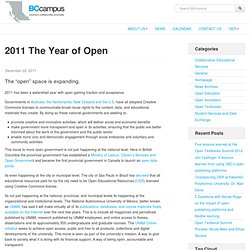
Governments in Australia, the Netherlands, New Zealand and the U.S. have all adopted Creative Commons licenses to communicate broad reuse rights to the content, data, and educational materials they create. By doing so these national governments are seeking to: promote creative and innovative activities, which will deliver social and economic benefitsmake government more transparent and open in its activities, ensuring that the public are better informed about the work of the government and the public sectorenable more civic and democratic engagement through social enterprise and voluntary and community activities This move to more open government is not just happening at the national level.
Its even happening at the city or municipal level. Its not just happening at the national, provincial, and municipal levels its happening at the organizational and institutional levels. Cloud-based educational technology and privacy: a Canadian perspective. Cloud computing for education: A new dawn? <div class="msgBox" style="margin-top:10px;"><span class="errMsg"><div>JavaScript is disabled on your browser.
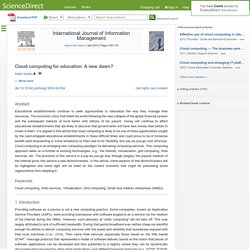
Please enable JavaScript to use all the features on this page. This page uses JavaScript to progressively load the article content as a user scrolls. Click the View full text link to bypass dynamically loaded article content. <a rel="nofollow" href=" full text</a></div></span></div><br /> Nabil Sultan, Author Vitae Faculty of Business and Computer Science, Liverpool Hope University, Hope Park, Liverpool, L16 9JD, UK Available online 23 October 2009 doi:10.1016/j.ijinfomgt.2009.09.004.
Cloud computing for education: A new dawn? Highered. Top 5 benefits of Cloud computing for the Education sector. Cloud computing simply explained is a flexible delivery model for ICT services that uses powerful systems and networks with high transfer rates.
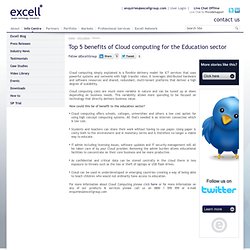
It leverages distributed hardware and software resources and shared, redundant, multi-tenant platforms that deliver a high degree of scalability. Final%20cloud%20computing%20tech%20briefing. Cloud Computing – Education will Never be the Same. Cloud computing ("the cloud") represents the most significant change to the way we use information technology since the introduction of the World Wide Web.

The cloud allows us to access our work anywhere, anytime and share it with anyone. It frees us from needing a particular machine to access a file or an application like a word processor or spreadsheet program. The cloud is changing the way people communicate, work and learn and, as a result, it is changing the way they pursue post-secondary education and how post-secondary institutions are meeting their needs. In this changing environment, it’s important that we think about the opportunities and risks that cloud computing presents for the post-secondary education sector, what we can learn from how some are already making use of this technology, and how we proceed from here. Effective use of cloud computing in educational institutions. Volume 2, Issue 2, 2010, Pages 938–942 Innovation and Creativity in Education Edited By Hüseyin Uzunboylu Abstract Cloud computing is becoming an adoptable technology for many of the organizations with its dynamic scalability and usage of virtualized resources as a service through the Internet.
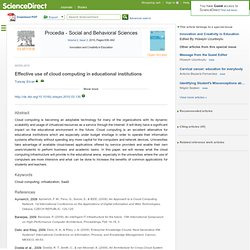
It will likely have a significant impact on the educational environment in the future. Keywords. Government needs inspiring IT teachers to address chronic lack of specialists. The Royal Society is urging the government to increase the number of specialist ICT teachers in the UK to support its decision to replace the ICT curriculum with one that focuses on the fundamentals of computer science.
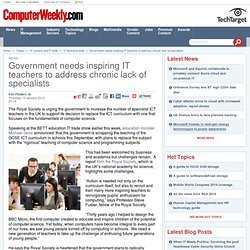
Speaking at the BETT education IT trade show earlier this week, education minister Michael Gove announced that the government is scrapping the teaching of the GCSE ICT curriculum in schools this September, with plans to replace the subject with the “rigorous” teaching of computer science and programming subjects This has been welcomed by business and academia but challenges remain. A report from the Royal Society, which is the UK’s national academy for science, highlights some challenges. “Action is needed not only on the curriculum itself, but also to recruit and train many more inspiring teachers to reinvigorate pupils’ enthusiasm for computing,” says Professor Steve Furber, fellow of the Royal Society.
In its latest report, Shut down or Restart? Email Alerts. Cloud computing in education: How moving to the cloud can help schools. The UK public sector, including education departments, can enjoy the same benefits of virtualisation and cloud services that commercial organisations enjoy.
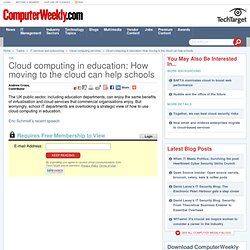
But worryingly, school IT departments are overlooking a strategic view of how to use cloud computing in education. Eric Schmidt’s recent speech. Six Advantages of Cloud Computing in Education. Image from iStock There is a lot of buzz about cloud computing right now—in fact, it is said that within one year, cloud computing in K-12 schools is expected to consume a quarter of the entire IT budget; four years from now, that figure will grow to 35 percent.
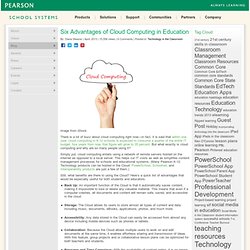
But what exactly is cloud computing and why are so many people using it? Simply put, cloud computing entails using a network of remote servers hosted on the internet as opposed to a local server. This helps cut IT costs as well as simplifies content management processes for schools and educational systems. The Benefits of Cloud Computing in Education are Huge! : Aspect Blogs. By Gail Staines on June 27th, 2013 There was a time when, to use files (word processing files, spreadsheets, etc.) on different computers, you needed to save your files on a thumb drive or CD-ROM disk. The drive or disk then travelled around with you so that you could load your information onto other computers while holding your breath until the document or PowerPoint slide was actually retrieved!
Smartphones expected to drive most work from the desktop to ‘the cloud’ Smartphones expected to drive most work from the desktop to ‘the cloud’ Most experts surveyed in Pew Internet/Elon University study say cloud computing is taking over; some warn about security, privacy, availability of broadband spectrum, and issues related to consumer choice and control Nearly 900 Internet experts and highly engaged users said they expect people who use the Internet will “live mostly in the cloud” by 2020, working primarily through the use of cyberspace-based applications on remote servers that we access through our networked devices.
This does not mean, however, that most think the desktop will disappear soon. “Cloud computing” takes hold as 69% of all internet users have either stored data online or used a web-based software application. “Cloud computing” takes hold as 69% of all internet users have either stored data online or used a web-based software application Some 69% of online Americans use webmail services, store data online, or use software programs such as word processing applications whose functionality is located on the web. Cloud Computing in K12. Cloud computing. Cloud computing metaphor: For a user, the network elements representing the provider-rendered services are invisible, as if obscured by a cloud. Cloud computing is a computing term or metaphor that evolved in the late 1990s, based on utility and consumption of computer resources.
Cloud computing involves application systems which are executed within the cloud and operated through internet enabled devices. Purely cloud computing does not rely on the use of cloud storage as it will be removed upon users download action. Clouds can be classified as public, private and hybrid.[1][2] Head in the Clouds: The Benefits of Celestial Storage. I've been thinking about cloud technology over the past few weeks and thought I would share a few great reasons why educators should consider making the move into the cloud. Back It Up This is the third time I am writing this post. Yes, the third time. Who owns the learning? 4413acij02. Proposing an education database based on Cloud computing. WyldCloudReport_0.
The Downtime Dilemma: Reliability in the Cloud. When I’m not blogging for Software Advice, I like to do a little personal writing of my own. I use Google’s Blogger as my platform for reflection. A couple of weeks ago, I tried to create a new post, but like thousands of other Blogger-ites, I was unable to do so. After a quick search on Twitter and various user boards, I realized Blogger was down. The application was unavailable for about 20 hours. EST1008. EST0902. Viewcontent. Cloud in Higher Education - Cloud Computing & Virtualization 2012. Cloud Computing in Education. Education 3.0: Embracing Technology to 'Jump the Curve' Image: USDAgov/Flickr It may not be “The Winds of War.” It may not even be as exciting as “Sharknado,” but I would argue that the role of ed tech in Education 3.0 is far more important than anything Hollywood has produced (and definitely more valuable than sharks dropping from the skies?) Education 3.0 is what we can achieve when we begin to transform education.
It’s the underpinning for things that we know, frameworks that we are creating, and models that we have studied for years. Education 3.0 is what I believe we can aspire to so as to educate our students, at all levels, in ways that actually promote 21st-century skills and prepare them for the jobs of tomorrow (aka, the jobs that don’t exist today but which will be required in the future). From Pencils to Personalized Learning: What is Ed Tech?
Ed Tech has taken on a whole new meaning in the last two decades. We Can’t Afford to Slow Down: Focus on Tomorrow Fast forward to today and you find a procedure that costs about $10,000. Dr. If Everything Is ‘In The Cloud’, Why Isn’t IT Education? Image: courosa/Flickr “The cloud” was, not so long ago, an abstract term just beginning to bud in the business world. At the time, many of us likely had no idea it would become the technology explosion it is today. These days, if you are not “in the cloud” than you are out of date. Evaluating-Cloud-Computing-Solutions-to-Find-a-Balance-Between-Innovation-and-Cost-Savings-and-Priva.